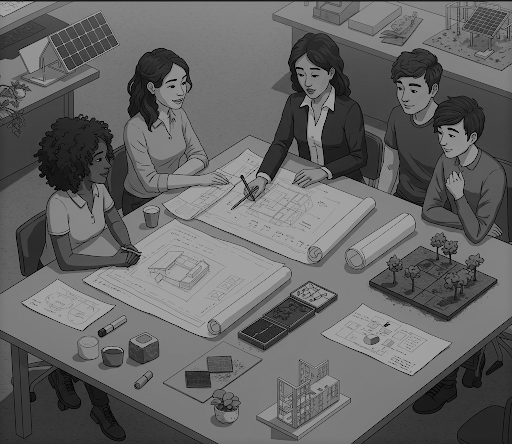25
Apr 2025
Sustainable Design via Responsible Learning
Fostering Sustainability Through Responsible Architectural Education
Sustainability is the way of life that meets present needs without compromising the needs of future generations. With increasing population and widespread urbanization the world is grappling with alarming challenges – ranging from climate change to resource depletion and pollution to declining quality of life.
Architects are neither environmentalists, nor are climatologists equipped to directly solve these challenges. They aren’t the key decision-makers when it comes to climate action or sustainable development policies. So where do they fit in this conversation? Why do they play a crucial role in sustainable development?
As per the 2022 Global Status Report for Buildings and Construction by UN, the Building industry accounts for over 34 percent of energy demand and around 37 per cent of energy and process-related CO2 emissions in 2021. The statistics clearly indicate the contribution of the building industry on climate change. As architects are critical stakeholders in the realms of built environments, they hold immense potential to steer the future towards sustainable development.
The sustainability movement first emerged in the 19th century as a response to consequences of industrialization. Though many leading architects and architecture firms became the leading protagonists of sustainable architecture practices, there were very limited institutions or individuals who initiated the same through meaningful changes within architectural education.

Ian Macharg was one of the very few to bring a change in the architectural education system by establishing the department of landscape in University of Pennsylvania in 1973. He also inspired generations of architects through his book ‘ Design with Nature.’

It is crucial that the architects are trained to be climate responsive and be aware of the context. Their education should enable them to not only be sensitive and responsible towards planet earth but also empower them to raise awareness and inspire clients and allied professionals, amplifying their impact for a sustainable future.
In today’s time when sustainable development is no more a choice but a necessity, more and more architecture institutions are integrating sustainability with their curriculum to shape a new generation of environmentally-conscious architects.

Some of the initiatives for sustainability focused education include:-
- Holistic and Interdisciplinary Curriculum – Usually climate responsiveness is taught in isolation as a stand alone subject, which limits the application of the knowledge in on ground situations. It is crucial to blend the understanding of sustainable design practices with other subjects like Design Studios, Building Construction, Building Materials, etc. It will help students to embed sustainable practices into their design thinking.
- Dynamic Curriculum – The traditional architectural curriculum focuses more on form or function based approaches to design. Additionally the curriculum also struggle to keep pace with the contemporary practices and rapid innovation. And so it’s essential to develop curriculum which focus more on climate responsiveness and social impacts of the built environment and also upgrade the curriculum periodically to align with emerging issues, trends, technologies and innovations in sustainable architecture.
- Establishment of Specialized Departments – Establishing dedicated departments like Environment planning and Landscape architecture can significantly enhance interdisciplinary and integrated learning within architectural education. In addition to offering specialized courses these departments can support collaborations with experts from relevant fields such as climatology, sustainable construction techniques, soil engineering and eco-friendly materials. These departments help in bridging the gap between design, technology and environmental consciousness.
- Dedicated Research Cells – The institutions can also form dedicated research cells for conducting avant-garde research in sustainable development, climate and environmental studies adding to the existing knowledge and ideas. They can play a vital role in advancing knowledge and contribute in shaping the ongoing discourse around sustainability in architecture.
- Interdisciplinary Collaborations – To make students more aware about the current practices and practical training the institutions can also collaborate with government agencies, industries and N.G.O.’s for enhancing integrated learning and promoting design innovations in the green building industry. Such partnerships enrich the academic ecosystem by bringing in diverse perspectives. They help in preparing students to address complex environmental challenges through holistic and informed design solutions.
- Green Certification Programs – By partnering with recognized Green Building Rating Systems, institutions can offer certification opportunities to students who aspire to specialize in sustainable architecture. These credentials will help them to find placements in firms dedicated to Environmentally responsive designs.
Through the use of these various approaches we at L.S.Raheja School of Architecture are committed to train students to be environmentally responsible in their Design Methodology. Through holistic and interdisciplinary approaches the students are being nurtured for the field realities, ready to shape a sustainable and resilient future.
By-
Ar. Anisha Joshi
Assistant Professor – L.S.Raheja School of Architecture



